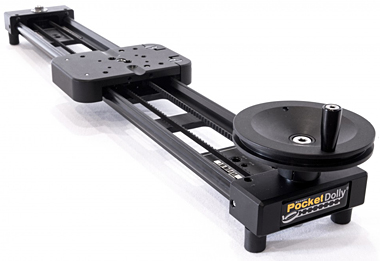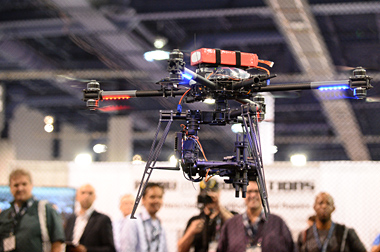Camera Support at NAB 2015 Points to a Major Trend

The Pocket Dolly from Kessler supports your inner crankiness.
ALEXANDRIA, VA.—Walking the floor of the NAB Show exposes you to lots of products, and it’s easy to be subjective about what you see. In my subjective opinion, one of the fastest-growing product categories in recent years is Camera Support, the products used to help steady a camera and allow the videographer latitude on shots.
In the past 25 years, we first saw the growth of Steadicam-like body-mounted stabilizers, then similar handheld products that could provide the same function for small lightweight cameras. These are still popular, but they are just one of a multiplying variety of camera support products.
Very popular in the past 10 years have been sliders, which let you smoothly move a camera in-and-out or side-to-side, adding a sense of motion to an otherwise static screen image. These are so popular that they are now common in films, scripted TV series, reality programs, documentaries and television news.
There were plenty of sliders at 2015 NAB Show, in all shapes, sizes and configurations. These included motorized sliders, ones with cranks and other manual motion mechanisms and tripod-mounted tracks with built-in curves. As cameras get smaller and yet more capable, the size and weight of sliders has been keeping track. That leads to some inexpensive professional products that provide a lot of bang for the buck.
One example was at the Varavon booth, where the company’s Slidecam Arc provided a curved one-meter track to add interest to shots. Another was the Kessler Pocket Dolly that has a big flywheel-stabilized crank to allow for smooth camera slides or dollies.

A drone takes flight in the Drone Pavilion. (Photo: Al Powers)
Get the TV Tech Newsletter
The professional video industry's #1 source for news, trends and product and tech information. Sign up below.
In the Central Hall, it seemed that one end was filled with innovative camera support gear that drives the hunger for ever-more creative shots.
Of course, drones were one of the most talked-about camera support products at the show, with a pavilion dedicated to several manufacturers’ products. Walking the floor, there were dozens of drones displayed in as many booths, as well as booths for drone manufacturers, often with flying cages.
Among others, 3DR and DJI had flying cages for their popular drones, and both drew steady crowds in the Central Hall. Drones were “this year’s top model” when it came to cool camera support products, but they were not the only interesting development.
A couple years ago, one of the interesting products was a handle with a gimbal-mounted platform for a camera. This made for interesting moving shots that mimicked the point-of-view of a person or animal. At this year’s NAB Show, there were more of these devices—and at lower prices.

Hien Le, CEO of Letus, demonstrates the company’s Helix Jr. gimbal stabilizer.
The first one to make a splash with a gimbal stabilizer was Freefly Systems’ MoVI, which has a couple different models for cameras of different sizes. At the show, DJI also drew a crowd with its Ronin Gimbal Stabilizer, which it had actually shown a year before. Another crowd pleaser was the Letus Helix Jr., a small and affordable gimbal stabilizer for small and affordable cameras.
In an interview with industry veteran Walter Schoenknecht, owner of Midnight Media Group, he said that one of the things that has impressed him with the trend toward smaller and more affordable video gear was its “empowerment.” It used to be that it took a truck full of expensive equipment to make a video, but that is completely changed today.
A clever and creative person today could make a watchable video—or even a movie—using a cell phone’s video camera, a few inexpensive accessories and editing software. That’s empowerment, and it means that more people than ever are thinking about video, making video and sharing video.
At the 2015 NAB Show, many of these empowered people were looking at the many forms of camera support products and thinking about how they can be used to create the next interesting video. If you didn’t spend time looking at the camera support gear, you might have missed one of the industry’s biggest trends.
